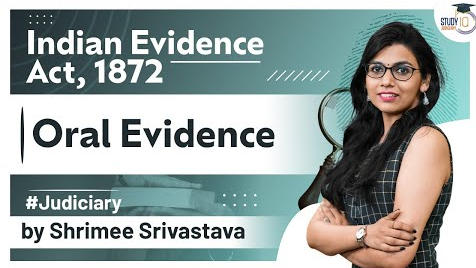Table of Contents
Oral Evidence
Introduction
- The word “evidence” is used in the Indian Evidence Act, 1872 in different phrases, i.e. best evidence, direct evidence, circumstantial evidence, documentary evidence, substantive evidence, corroborative evidence, derivative evidence, hearsay evidence, indirect evidence, oral evidence, original evidence, presumptive evidence, real evidence, primary evidence and secondary evidence.
- The Hon’ble Supreme Court in Kalyan Kumar Gogoi v. Ashutosh Agnihotri and Anr. [AIR 2011 SC 760], has held that “The word “evidence” is used in common parlance in three different senses:
- as equivalent to relevant,
- as equivalent to proof, and
- as equivalent to the material, on the basis of which Courts come to a conclusion about the existence or non-existence of disputed facts.”
- Oral and documentary evidence are the two main kinds of evidence.
- Oral evidence includes direct evidence and also substantive and corroborative evidence, whereas, documentary evidence only includes substantive and corroborative evidence.
- Section 59 and 60 of the Act deals with oral evidence.
- Oral evidence of a witness is generally admissible evidence if he has direct and personal knowledge of the fact deposed by him.
- Whereas, in the case of documentary evidence, the Act classifies documents into two types: one is a ‘public document’ in terms of Section 74 of the Act, and the other are certified copies as contained in Section 77 of the Act.
Section 59: Proof of facts by oral evidence:
- All the facts and circumstances may be proved by oral evidence by expressing or speaking except the contents of documents and electronic records. The contents of documents and electronic records cannot be proved by oral evidence.
Section 60 – Oral Evidence must be Direct
- This is the cardinal principle of any evidence to be admissible in the court.
- If any oral evidence needs to be admissible, all the conditions under Section 60 of the Indian Evidence Act must be fulfilled.
- Oral evidence and section 60 is a proportional equation. For acting out one, the other needs to be fulfilled.
- The base principle on which section 60 is placed is that the evidence which is taken into regards must be direct.
- The word direct does not include any category of hearsay as its main element is vested in the word “must”.
- Every statement under oral evidence must be direct.
Meaning of hearsay Evidence
- All of us are aware of what hearsay is; hearsay is any information which is received by any person from any other source.
- Hearsay means when a person does not have a personal knowledge about a particular matter or incident and he has been informed about that particular matter by any other person.
Rationale behind the exclusion of Hearsay Evidence
- We know that Hearsay Evidence is second-hand knowledge.
- For oral evidence to be admissible it only accepts the rule of first-hand knowledge.
- It only includes what is directly seen, heard and perceived by a person.
- There is no room for second-hand knowledge.
- A conviction passed on hearsay may be truly unjustified as there is no reliability as to whether the person who has passed on the following information is credible enough or not.
- For example: if A has received information through B that he saw C hitting D. This will be hearsay because A himself has not administered the incident. For this reason, Hearsay has been excluded from Oral Evidence.
Download| Free PDF






















 WhatsApp
WhatsApp